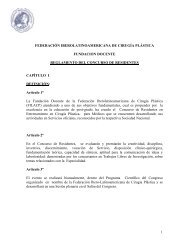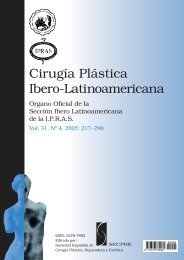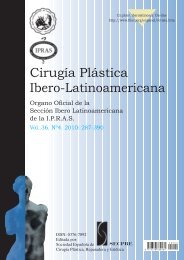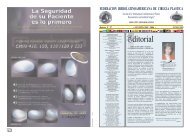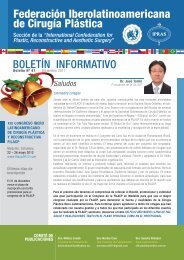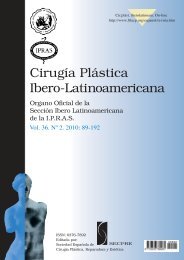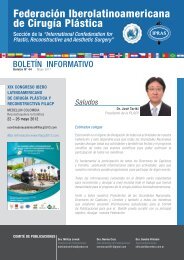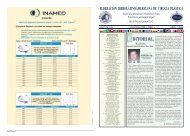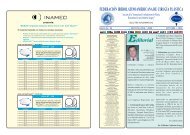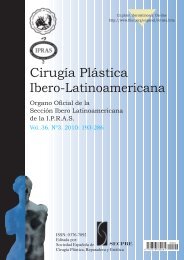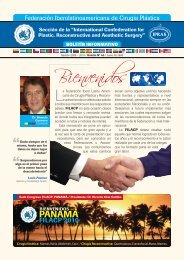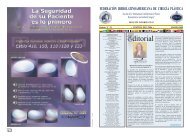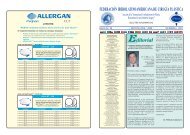Volumen 37 No. 4 - Planetec
Volumen 37 No. 4 - Planetec
Volumen 37 No. 4 - Planetec
You also want an ePaper? Increase the reach of your titles
YUMPU automatically turns print PDFs into web optimized ePapers that Google loves.
Eficacia de un apósito autoadhesivo de poliuretano para prevenir la formación de cicatrices hipertróficas<br />
Muy probablemente, la eficacia de los apósitos TRC<br />
se debe a que ejercen un efecto de presión y de mantenimiento<br />
de los bordes de la herida de manera constante<br />
durante las 24 horas del día. Su fácil aplicación por parte<br />
del propio paciente y la facilidad con que se adapta a los<br />
diferentes espacios anatómicos, suponen también ventajas<br />
importantes frente a otros métodos tradicionales.<br />
Dr. Javier Bisbal.<br />
Clínica Planas<br />
Pere II de Montcada, 16.<br />
08034 Barcelona. España<br />
e-mail: 7193jbp@comb.cat<br />
Dirección del autor<br />
Agradecimientos<br />
Al Profesor Jordi Mallol, Catedrático de Farmacología<br />
de la Facultad de Medicina y Ciencias de la Salud de<br />
Reus (Universidad Rovira i Virgili) por su colaboración<br />
en la valoración de los resultados del estudio, especialmente<br />
en lo que respecta al cálculo estadístico.<br />
Bibliografía<br />
1. Ferguson M.W., Whitby D.J., Shah M., Armstrong J.<br />
y Siebert J.W.: Scar formation: the spectral nature of<br />
fetal and adult wound repair. Plast Reconstr Surg, 1996;<br />
97 (4): 854.<br />
2. Bayat A., McGrouther D.A. y Ferguson M.W.J.: Skin<br />
scarring. BMJ, 2003; 326 (7380): 88.<br />
3. Bell L., McAdams T., Morgan R., Parshley P.F., Pike<br />
R.C., Riggs P. y Carpenter J.E.: Pruritus in burns: a<br />
descriptive study. J Burn Care Rehabil, 1988; 9 (3): 305.<br />
4. Woo S.H. y Seul J.H.: Optimizing the correction of severe<br />
postburn hand deformities by using aggressive contracture<br />
releases and fasciocutaneous free tissue transfers.<br />
Plast Reconstr Surg, 2001; 107 (1): 1.<br />
5. Mustoe T.A., Cooter R.D., Gold M.H., Hobbs R., Ramelet<br />
A.A., Shakespeare P.G., Stella M., Téot L.,<br />
Wood F.M. y Ziegler U.E.: International Clinical Recommendations<br />
on Scar Management. Plast Reconstr<br />
Surg, 2002; 110 (2): 560.<br />
6. Tandara A.A. y Mustoe T.A.: The role of the epidermis<br />
in the control of scarring: evidence for mechanism of action<br />
for silicone gel. J Plast Recons Aest Surg, 2008; 61<br />
(10): 1219.<br />
7. Cruz-Korchin, N.I.: Effectiveness of silicone sheets in<br />
the prevention of hypertrophic breast scars. Ann Plast<br />
Surg, 1996; <strong>37</strong> (4): 345.<br />
8. Chan K.Y., Lau C.L., Adeeb S.M., Somasundaram S.<br />
y Nasir-Zahari M. A.: Randomized, Placebo-Controlled,<br />
Double-Blind, Prospective Clinical Trial of Silicone<br />
Gel in Prevention of Hypertrophic Scar Development in<br />
Median Sternotomy Wound. Plast Reconstr Surg, 2005;<br />
116 (4): 1013.<br />
9. Fernandez García, A. y col.: Evaluación colorimétrica<br />
digital de las cicatrices patológicas: Estudio comparativo<br />
entre gel de silicona y fotoprotector. Cir. plast. iberolatinoam.<br />
2010, 36 (2): 167.<br />
10. Atkinson J.A, McKenna K.T., Barnett A.G., McGrath<br />
D.J. y Rudd M.: A randomized, controlled trial to determine<br />
the efficacy of paper tape in preventing hypertrophic<br />
scar formation in surgical incisions that traverse<br />
Langer's skin tension lines. Plast Reconstr Surg, 2005;<br />
116 (6): 1648.<br />
347<br />
Cirugía Plástica Ibero-Latinoamericana - Vol. <strong>37</strong> - Nº 4 de 2011



